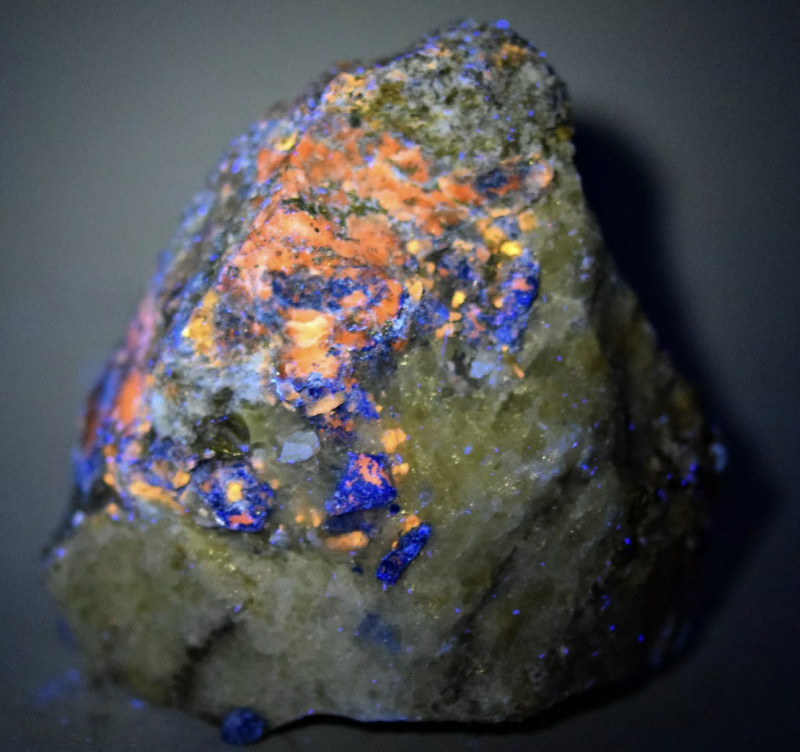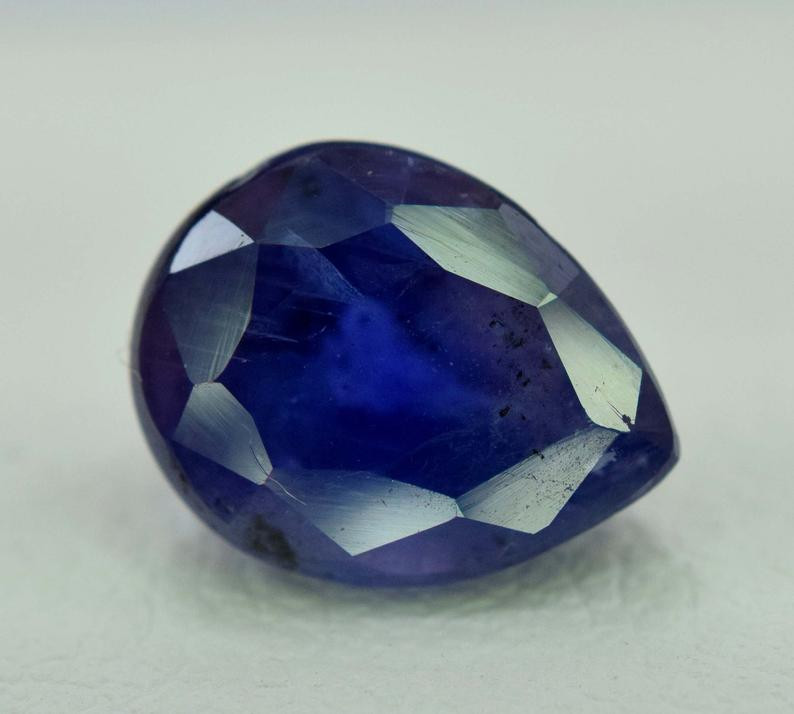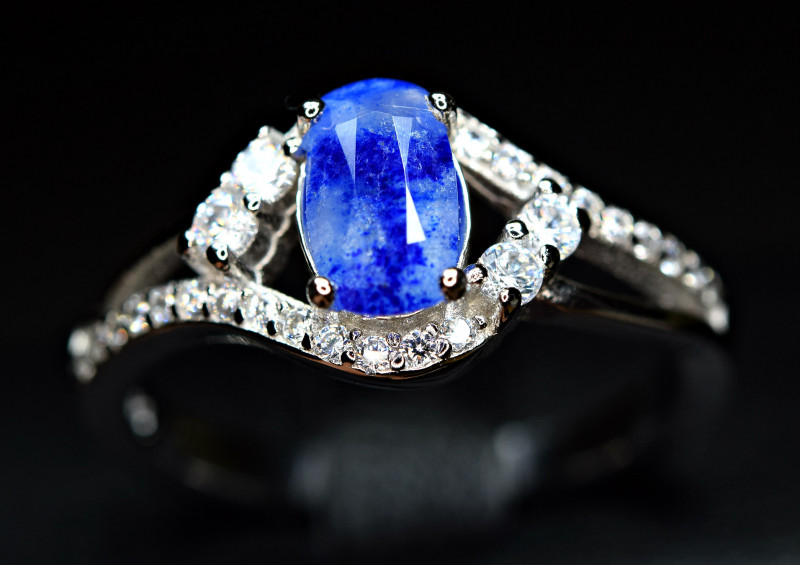
Afghanite Gemstone: Properties, Meanings, Value & More
 Afghanite is a truly complex gemstone with much mystery surrounding its history!
Afghanite is a truly complex gemstone with much mystery surrounding its history!
The afghanite mineral typically appears in striking shades of light to dark saturated blue and is sometimes colorless. Gems are heavily included and often associated with lazurite and sodalite.
Is afghanite rare? It’s very rare — it can only be found in a handful of localities around the world. Afghanite’s scarcity and beauty make it a highly sought-after collector’s stone.
Excited to learn more about this rare and mystifying gemstone? Keep reading to find out all there is to know about afghanite properties, value, uses, origins, and more!

What is Afghanite Stone?
Afghanite gets its name from its place of discovery — Afghanistan!
This semi-precious gemstone is best known for its deep shades of blue, similar to blue onyx and lapis lazuli. Like most blue gems, afghanite is associated with the element water.
Afghanite isn’t an official zodiac or star stone, but it’s believed to attune to the Scorpio sign in astrology. Its profoundly peaceful energy brings a sense of calm when things get too intense for fiery Scorpios.
Next, let’s take a peek at afghanite’s mineral data!

Afghanite Specifications & Characteristics
Afghanite is a feldspathoid of the cancrinite group that usually occurs with sodalite group minerals (lazurite or hauyne). Stones are often speckled with dazzling blue inclusions of lazurite.
This mineral tends to form as elongated or prismatic crystals (in the pyramidal form), small tabular crystals (in the massive form), or grainy encrustations on limestone.
Here’s an overview of afghanite crystal properties:
Chemical formula: (Na, Ca, K)12-(Si, Al)16O34(Cl, SO4, CO3)4.H2O
Mineral Family: Cancrinite group
Composition: Silicate
Mohs hardness: 5.5 to 6
Color: White, variations of blue, or very pale, almost colorless
Crystal structure: Trigonal
Luster: Vitreous (Glassy)
Transparency: Transparent to opaque
Refractive index: 1.52 to 1.53
Birefringence: 0.006
Density: 2.55 to 2.65
Cleavage: Perfect, 1 direction on [1010]
Fracture: Conchoidal to uneven
Streak: White
Luminescence: Fluorescent (yellow in LW-UV, orange-red in MW-UV, orange in SW-UV)
So how did afghanite come to be?

Afghanite Meaning & History
Afghanite was discovered by R. Giraud, F. Cesbron, and P. Bariand in 1968. They named the gem after Afghanistan, the country where they found it. The mineral can be specifically traced to the Badakhshan region in northeastern Afghanistan.
Badakhshan is one of the world's poorest, most remote corners, nestled in the Hindu Kush Mountains, bordering both Tajikistan and Pakistan.
The region’s one claim to fame is the mining of lapis lazuli, a beautiful blue stone favored by ancient Egyptian and Roman civilizations. Afghanite was discovered in a lapis lazuli mine in this area but has since been found with other blue minerals (like sodalite) in other locales worldwide.
Since it’s a fairly recent discovery, there’s still much to be learned about afghanite. It has garnered little folklore since being unearthed just over 50 years ago.
Many believe that the Afghanistan specimens were actually a re-discovery. They claim that afghanite was originally collected from the Mount Vesuvius region of Southern Italy over a century earlier, around 1910. Then, it was named "natrodavyne." However, it was then allegedly lost until being recently re-identified in Afghanistan.
Moving on, let’s discuss how afghanite metaphysical properties can support your wellness!

Afghanite Healing Properties
Each gemstone has distinct characteristics enabling us to use them as healing stones. They can aid in the balance and health of your spiritual, emotional, and physical body.
Afghanite is no exception. Its vibrations and energy may help boost your physical health, soothe negative emotions, balance the chakral body, and attract good vibes into your space.
Physical Healing
So what is afghanite used for? The mineral may decrease (even eliminate) some types of pain, especially those near the top of the body like headaches or migraines.
Afghanite is said to positively affect your cognition and help you think more clearly. Moreover, it can help those who struggle with insomnia by calming the mind and enhancing sleep.
Emotional Healing
Afghanite crystal benefits your emotional body in a similar fashion — by calming your energy and providing clarity. It’s believed to help you digest and process information, as well as deliver clarity on navigating difficult situations.
Keep an afghanite crystal clutched in your palm the next time you face a crossroads. Afghanite may help lead you in the right direction.
Chakra Healing
Some crystals can be used as chakra stones to open, activate, or clear your chakras. The chakras are several energy points along the center of your body.
Afghanite uses its energy and vibrations to balance the third eye and crown chakras.
By stimulating the crown chakra, afghanite enables you to think more critically and clearly. It keeps you sharp and enhances your intuition.
Afghanite supports your third eye by awakening psychic abilities. This makes you more open to receiving messages from spirit guides and celestial beings.
Balancing Energy
In Feng Shui, the ancient Chinese practice of balancing energy through arranging your space, the afghanite crystal meaning is associated with water.
Placing afghanite near a water source by your front door is believed to attract prosperity into the space. While the size of the fountain isn’t a factor, it’s crucial the water flows inward (towards the interior) rather than outward.
Now that you’ve got the run-down on afghanite’s metaphysical healing powers, let’s see how its physical traits fare in value!

Afghanite Gemstone Properties
As with most gems, afghanite’s value stems from standard properties like color, cut, clarity, and weight.
Here’s what to look for when shopping for afghanite:
Color
Afghanite presents a range of blue hues — from light to dark, pastel to vivid, and even completely colorless. Its blues are quite similar to lapis lazuli, mainly because afghanite shares a similar chemical formula to lazurite, lapis lazuli’s main component. Both are members of the impossibly large tectosilicate mineral group.
Cut
Afghanite gemstones are cut in many ways, ranging from traditional faceted cuts to beads, cabochons, and unique carvings. The most common carved shapes are afghanite spheres, pyramids, and palm stones (for meditation).
Rough (or raw) afghanite is almost unobtainable, and good-quality crystals are rare.
Clarity
Afghanite usually contains lazurite inclusions of varying blue shades. These inclusions can be speckled (similar to what you see in granite) or vein-like (similar to what you see in marble).
The Gemological Institute of America (GIA) classifies afghanite as a Type II colored gemstone clarity grade. In other words, eye-clean clarity is usually the standard.
Typically, the higher the transparency, the higher the quality and, therefore, value.
Carat Weight & Size
Gems are categorized in carats, but rough (or raw) afghanite is commonly measured by grams.
Gem-quality afghanite is very rare; most specimens are under 3 carats. Large specimens of rough afghanite are even rarer. Anything large tends to garner higher prices.
What is afghanite made of, anyway? Let’s find out!

Afghanite Formation & Sources
Afghanite is a feldspathoid (a feldspar-like mineral) of the cancrinite group. It typically occurs in thin veinlets piercing lazurite crystals or silicified limestone xenoliths (a foreign rock fragment) in pumice.
What type of rock is afghanite found in? Metaphoric! Afghanite is born in the crushing heat and pressure caused by mountain-building. As tectonic plates collide — crumbling, folding, and piling up — they thrust upwards forming mountains. Afghanite occurs between the crumbles and folds of the metamorphosed rock!
Mining Locations
We know the general consensus is that afghanite was discovered in the Sar-e-Sang Badakhshan Province of Afghanistan just over 50 years ago — but what about today?
Since 1968, deposits have been discovered in several localities around the world. Apart from Afghanistan’s Badakhshan Province, you can find afghanite in:
Canada (Newfoundland)
Germany
Italy (Tuscany, Campania, & Latium)
Russia (eastern Siberia)
Tajikistan (Pamir Mountains)
United States (New York)
Ready to shop for some afghanite of your own? Next, we’ll tell you what to expect in terms of price.

Afghanite Price & Value
Afghanite is considered a rare collectors’ mineral. Therefore, gems tend to be more expensive than more abundant counterparts.
Faceted afghanites start around $125 to $284 per carat. However, high-quality faceted gems with particularly distinct fluorescence can fetch prices as high as $1,052 per carat.
Prices for afghanite cabochons vary. They can sell as low as $121 per carat or up to $307 per carat. Carvings and sculptures range in price depending on size, stone quality, and design intricacy. Smaller pieces usually start at around $38 increasing from there.
As a relatively soft stone, with a hardness of 5.5 to 6, afghanite is best suited for pendants, earrings, or rings with protective settings.
Simple pendant necklaces can start around $15 for lower-quality gems and reach about $40 for higher-quality pieces. Low-quality earrings can start at about $23, with higher-quality ones starting at about $68 per pair.
Afghanite rings tend to be the pricier category among afghanite jewelry, with prices ranging between $40 and $1,400.
Afghanite rough prices depend greatly on inclusions, fluorescence, and size. Prices fluctuate vastly starting as low as $0.19 per carat and going well beyond $25 per carat.
So how do you ensure your afghanite lasts for years to come? Let’s talk gemstone care!
Afghanite Care and Maintenance
Afghanite is pretty durable, but it’s not indestructible. It can scratch, chip, or shatter if you aren’t careful.
Warm, soapy water works best for cleaning your afghanite gemstones. Wash the gem gently and pat dry with a soft, non-abrasive cloth.
Avoid your afghanite coming into contact with:
Harsh chemicals
Perfumes & cosmetics
Ultrasonic cleaners
Steam cleaners
Abrasive minerals
Sudden temperature changes
You should also avoid wearing afghanite during impact-prone activities. To be safe, store your afghanite gems in a soft, fabric-lined box or fabric pouch separately from other gems to prevent damage from it impacting harder minerals.
Afghanite Cleansing
Unlike cleaning, cleansing refers to spiritually purifying your crystals. This helps your gems return to their original, maximum healing energy and clears any negative energy they've absorbed. Think of it as a reset for your crystals!
To cleanse and renew your afghanite, you can use one of these methods:
Hold it under running water for 2-5 minutes
Soak it in vinegar water for 5-10 minutes
Let it sit in the sun for a full day
Bury it in soil overnight

Go Into the Blue with Afghanite!
Even with all the mystery surrounding afghanite, it’s not hard to see why this crystal is so popular among astute collectors.
It literally clears your mind and refreshes your perspective. On top of its metaphysical abilities, afghanite’s striking shades of blue are sure to catch every eye.
Who knew feelin’ the blues could look and feel so good?
Search the Gemstone Encyclopedia
Related Auctions
Related Articles
Originally the Birthstones or gemstones were associated with a zodiac sign or the month of a individuals birth. Find out what your stone is and view the stones we have for sale
8th Feb 2021
There are dozens of quartz and chalcedony gems with various colors and patterns. Learn all about quartz properties and every type of quartz, from amethyst and agate to plasma and phantom quartz!
15th Oct 2020
Hackmanite is a pink to violet sodalite gem known for its unique color-change and luminescence. Learn why hackmanite is special, from its rare qualities to the types of hackmanite jewelry available.
28th Mar 2018
Latest Articles
Simpsonite is a lesser-known mineral known on the gem market for its durability, yellow-orange color, and rarity. Discover all the properties, uses, prices, and history of simpsonite.
3rd Mar 2025
Kurnakovite is a colorless crystal related to inderite and rarely faceted but known among collectors. Explore the mineral traits, history, prices, and more in this kurnakovite guide.
17th Feb 2025
Prosopite is an uncommon gemstone known for its rare robin’s egg blue form used for cabochons. Discover the history, benefits, prices, and powers of prosopite gemstones!
3rd Feb 2025
Article Categories
How To's is where you will find helpful articles from gem Rock Auctions on how to cut gemstones, select gemstones and buy gemstones.
9 Articles




